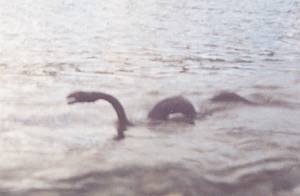Nahuelito is a lake monster reported to live in the waters of Nahuel Huapi Lake, at the foot of the Patagonian Mountains in Argentina.
Description
Descriptions of the creature have varied from that of a giant water snake with humps and fish-like fins to a swan with a snake's head, the overturned hull of a boat, and the stump of a tree. Estimates of the creature's length range from 15 to 150 feet. Nahuelito is said to surface only in the summer, when the wind is still. Witnesses say that a sudden swell of water and a shooting spray precede the surfacing of the creature.
Place
Lake Nahuel Huapi lies at the base of the Patagonian Mountains and covers an area of exactly 318 square miles. Unlike other more remote aquatic habitats, such as Lake Van, Lake Labynkr or Lake Khaiyr, which purportedly harbor large, sub-aquatic animals, Nahuel Huapi is the home of one of South America's most famous resorts, the Bariloche, which boasts over 100,000 tourists every year.
Sightings
- The earliest known encounters with this animal can be traced to the Nahuel Huapi's native population, which for centuries told of a gigantic creature, dwelling in the lake. These original native accounts described the beast as being without a head, legs, or tail.
- Modern reports of this strange animal can be traced back to 1897, when a Patagonian farmer reported that he had witnessed a long necked creature, swimming in the water and had, on more than one occasion, heard a heavy dragging sound emanating from the stone covered beach during the night.
- The most detailed historical report of this monster harkens back to 1910. George Garrett, who at that time was managing a company based near Lake Nahuel Huapi, is credited with one of the rare off shore sightings of the creature. The account was chronicled in the Toronto Globe on April 6, 1922 (a total of twelve years after the event) to coincide with what was at the time the burgeoning "Patagonian plesiosaur" controversy. As quoted from the article:
- "We were beating windward up an inlet called 'Pass Coytrue,' which bounded the peninsula. This inlet was about five miles in length, a mile or so in width, and of an unfathomable depth. Just as :we were near the rocky shore of the peninsula, before tacking, I happened to look astern towards the centre of the inlet, and, to my great surprise, I saw about a quarter of a mile to leeward, an :object which appeared to be 15 or 20 feet in diameter, and perhaps six feet above the water. After a few minutes, the monster disappeared."
- As interesting as Garret's testimony was, far and away the most famous report comes to us from the early part of the 1920's, when American gold prospector Martin Sheffield, claimed to have seen an aquatic animal which moved like a crocodile, but bore an extended, swan-like neck.
- It was the Sheffield sighting which spurred the unsuccessful Buenos Aires Zoo expedition of 1922. The troubles which beset this probe into the depths of Nahuel Huapi were numerous and included a confrontation with the President of the Society for the Protection of Animals, one Dr. Albarrin, who petitioned the Minister of the Interior to refuse permits to the expedition on the grounds that the creature in question came under law which forbade the hunting of rare animals.
- The good doctor accurately sited the fact that the Onelli expedition was armed with both elephant rifles :and dynamite, which clearly indicated that there purposes did not fall under the spectrum of mere :scientific observation.
- As recently as 1994, two young women (Paula Jacarbe and Jessica Campbell), while sunbathing on the shores of Nahuel Huapi - in an area known as the Peninsula de San Pedro - witnessed what they described as a headless whale with a humped back and small fins along the side, frolicking in the water. The women immediately began shouting to the other tourists, trying to find someone with a camera - to no avail. Both women claimed that the most striking aspect of the creature was the sound it made while breathing.
- On April 17, 2006 the local newspaper El Cordillerano [1] reported that an anonymous photographer dropped off two pictures of what he said is Nahuelito with a note that read "It is not a twisted tree trunk. It is not a wave. Nahuelito has shown his face. Lake Nahuel Huapi, Saturday April 15, 9 o’clock. I’m not giving out my personal information in order to avoid future headaches" [2]
Theories
- The older theory about Nahualito made it a survivor from the Jurassic-Cretaceous period and was probably inspired by Arthur Conan Doyle's The Lost World, where one of the characters describes a lake monster he once sighted, as a "creature like a huge swan, with clumsy body and a high flexible neck." However, though occasionally described with the archetypal small head and swan-like neck of the plesiosaur, Nahualito is more often reported as being whale-like in appearance, with large humps on its back and multiple fins along its side. This had led some researchers to propose that the creature may actually a colossal rogue sturgeon, or even a living descendant of an ancient, snake-like whale known as the Zeuglodon.
- Another theory is the "mystery submarine", based on a local belief that an unknown sub is prowling the lake's depths.
- Last but not least, some Argentinians are wondering if Nahuelito could be the result of nuclear experimentation by German scientists during the Peron regime in the 1950s.

